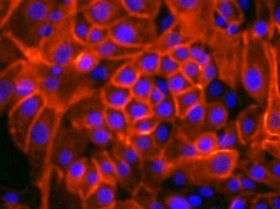Team finds way to create cancer stem cells

MIT scientists and colleagues have found a way to create in the lab large amounts of cancer stem cells, or cells that can initiate tumors. The work, reported in the August 13 issue of Cancer Cell, could be a boon to researchers who study these elusive cells. Labs could easily grow them for use in experiments.
The findings also contradict an assumption about the trajectory of cancer cells. According to current cancer models, any normal cell can evolve toward a malignant state through a series of alterations, including mutations. Given the right alterations, any cell could eventually acquire the ability to invade other tissues.
But the new study suggests that some normal cells are more prone to become tumor-initiating and have a higher potential to metastasize, or spread to other tissues.
According to the researchers involved in the current work, in some ways certain tumors resemble bee colonies. Each cancer cell in the tumor plays a specific role, and just a fraction of the cells serve as "queens," possessing the unique ability to maintain themselves in an unspecialized state and seed new tumors. These cells can also divide and produce the "worker" cells that form the bulk of the tumor.
These "queens" are cancer stem cells, and they are the cells recently created by MIT biology professor and Whitehead Institute Member Robert Weinberg and colleagues. They did so by isolating and transforming a particular population of cells from human breast tissue. After being injected with just 100 of these transformed cells, mice developed tumors that metastasized.
"The operational definition of a cancer stem cell is the ability to initiate a tumor, so these are cancer stem cells," said Weinberg.
Tan Ince didn't set out to engineer these potent cells. As a postdoctoral researcher in Weinberg's lab and gynecologic pathologist at Brigham and Women's Hospital, he was simply trying to create breast cancer models that look like real human tumors under the microscope and behave like those seen in many patients.
Now an independent investigator at Brigham and Women's and instructor at Harvard Medical School, Ince developed a recipe for a new chemically defined culture medium and managed to grow a different type of human breast cell that ordinarily dies in culture. He transformed it into a cancer cell by inserting specific genes through a standard procedure.
The engineered cells proved to be extremely powerful. When Ince injected more than 100,000 of them into a mouse with a compromised immune system, it quickly developed massive, deadly tumors. In initial experiments, a few tissue slices revealed a primary tumor structure that resembled that of cancer patients with metastases.
He repeated the experiment in other mice, reducing the number of cells in the injection to as few as 100. The cancer cells continued to seed tumors and those tumors metastasized.
In sharp contrast, scientists must inject about one million cells to get a tumor when working with the cancer cell lines routinely used in the laboratory.
The study also offers clues about the trajectory of cancer cells. A normal cell is thought to evolve progressively toward a malignant state through a series of genetic mutations. The early alterations confer uncontrolled growth, while later alterations enable the cell to migrate and invade other tissues.
The new study suggests, however, that some normal cells are more prone to become tumor-initiating cells and have a higher metastatic potential when they become cancer cells than other normal cells. The culture medium Ince created favors the growth of the human breast cells with high tumor-making and metastatic potential while the standard culture medium favors cells with low tumor-making potential. Although the two types are only slightly different, the cells behave completely differently after acquiring the same mutations.
Ince confirmed this behavioral difference by taking a single human breast tissue sample, splitting it in two and growing the cells in the two culture mediums, which select for different cells. Next, he transformed the two populations with the same tumor-initiating genes, injected them in mice and watched the result. The cells that were grown in the new culture medium were 10,000 times more potent as tumor initiators and were the only ones able to metastasize. Thus genes that were previously thought to only initiate tumors initiated metastasis, which is the main cause of cancer mortality in the clinic.
Ince's and Weinberg's colleagues on this work are Andrea Richardson, George Bell, Maki Saitoh, Samuel Godar, and James Iglehart. This research is funded by the Breast Cancer Research Foundation and the National Institutes of Health.
Source: MIT




















